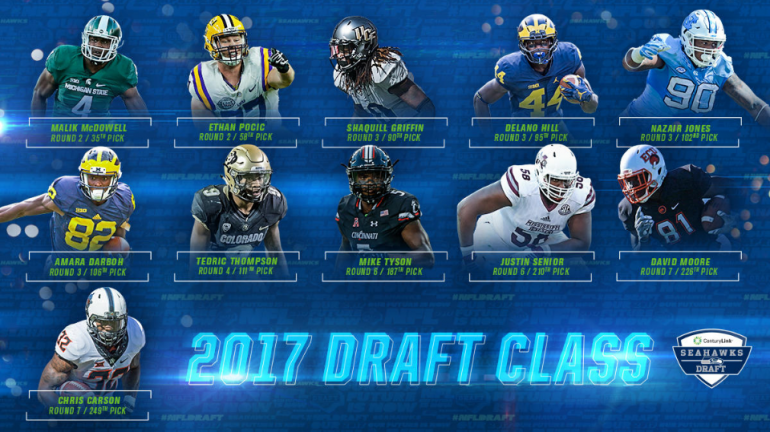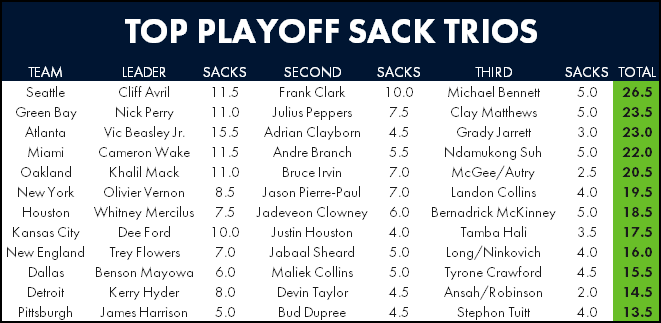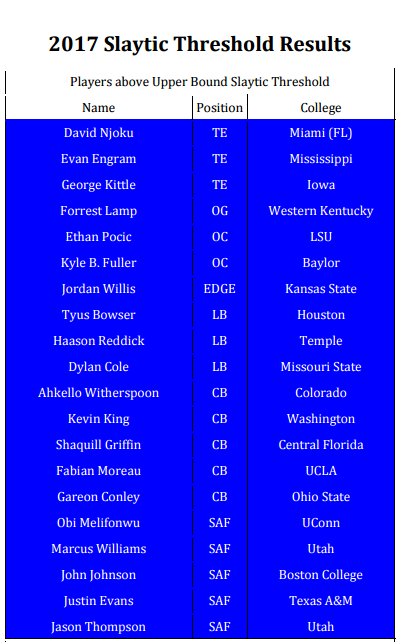The results are in. John Schneider and Pete Carroll selected 11 new players in the 2017 draft, tied with 2013 for the most players selected by the duo since joining up in 2010. As we saw in that season, quantity does not mean quality. Only Luke Willson remains on the team from that draft, and appears to have the ceiling of a solid role player. That 2013 class was widely panned as one of the least talented groups to come out of college, and that has proven out as the Seahawks added the 2nd (Luke Joeckel) and 3rd pick (Dion Jordan) of that draft to their roster for modest compensation. This class is expected to be far more talented, especially in the secondary. Schneider dipped deeply into that group, selecting four defensive backs, but none until the 90th pick. That will ultimately be the way this Seahawks draft will be judged. They addressed the right positions, but did they maximize their value? One thing is certain; there will be intense competition in training camp at positions that have been mostly stable.
What I am most excited about
1. The competition along the defensive line, and the potentially upgraded pass rush
The Seahawks had a damn good defensive line last year. They led the NFL in rush defense. They were tied for third in sacks. Michael Bennett, Cliff Avril, and Frank Clark were the top sack trio in the playoffs last year, and that was with Bennett missing considerable time due to injury.
Cassius Marsh also stepped up with 3.0 sacks. Those four are back, and now Malik McDowell, Quinton Jefferson, and Dion Jordan have been added to the mix. Carroll mentioned Jordan being used on the inside of the defensive line. The big fellas who focus on stuffing the run, Jarran Reed and Ahtyba Rubin are back and now have Nazair Jones to step in and help.
One thing that has held the Seahawks back a bit the past few years is the lack of interior pressure generated by their base defensive line. Guys like Rubin, Reed and Tony McDaniel were great at stopping the run, but did very little against the pass.
It is unclear exactly how Carroll wants to deploy McDowell, but if he can step in at the 3-technique defensive tackle where McDaniel started last year, he would appear to represent a major upgrade to Seattle’s pass rush on first and second down.
The assumption was that Reed and Rubin would start, and that Reed would replace McDaniel’s role, or that Jones would step into that role while Reed and Rubin rotated. The thought here is that McDowell takes over McDaniel’s role. To do that, he would need to prove he can be stout against the run first. Carroll will not tolerate a porous run defense just to get more pass rush out there. If it can work, however, that would allow Bennett and Avril to crash the edge on early downs, with Clark and Marsh available to rotate, with McDowell and Rubin inside with Reed and Jones available to rotate. In nickel situations, Bennett could slide inside next to McDowell and Clark and Avril could man the edges. Keep in mind that Jordan and McDowell are 6’6″ and Jones is 6’5″. That is a lot of height on the interior line.
2. Seattle added an elite athlete in Shaquill Griffin at corner
Ethan Young, a Seattle-based number cruncher who does scouting for Bleacher Report, created a new statistical measure for identifying transcendent athletes for the NFL. Some of you may be familiar with SPARQ (Speed, Power, Agility, Reaction, Quickness), which measures a number of athletic test scores to arrive at an evaluation of general athleticism. Nike bought SPARQ, but eventually stopped using it. It is believed the Seahawks gained an edge early on in the Carroll and Schneider era by using something like SPARQ in their draft evaluations. Once that information spread across the league, they lost that edge. Young saw some flaws in SPARQ. For example, it does not take into account and size or length measurables other than weight. To remedy that, he created the True Freak Rating to account for height, weight, arm length, and hand size. He took it a step farther by then blending SPARQ and the True Freak Rating into a composite score he calls SLA (Size, Length, Athleticism).
Young applied his new scoring system to the prospects coming out of college this year. I highly recommend reading his full report here and following him on Twitter here.
A large number of the Seahawks draft picks scored quite well. Griffin, though, jumps out as this was a deep cornerback class and he appears to be one of the top athletes available. Seattle has tried to take corners with clear athletic limitations later in the draft and lean on their coaching, scheme, and safety play to cover up their flaws. Griffin could be the exception.

I asked Young about his evaluation of the Griffin selection, and he made an interesting comparison.
“Yeah, big Griffin fan. That was a slam dunk fit,” Young said. “Two years ago they probably could have gotten a guy like that in the 5th, but the market is starting to adjust to those Seahawky CBs. He tested almost exactly like Aqib Talib, though his read and react ability on tape isn’t quite on that level.”
That is high praise, and worth being excited about. I will choose to ignore the guy sitting at #2 on the list who I really wanted with our first pick.
3. Ethan Pocic may actually be a decent offensive lineman
I admit to being pretty pissed when the Seahawks used their second selection on an offensive lineman instead of grabbing either one of the Colorado cornerbacks (#1 and #11 on the Slaytics chart above), or even a safety like Josh Jones or Obi Melifonwu. It was nothing against Pocic. It was just frustration at seeing the best players from the strongest part of this draft go by knowing this team needed to address the future of their secondary, coupled with the reality that this regime has a terrible track record of wasting early round picks on offensive linemen who just are not very good.
On further reflection, there are plenty of signs pointing to Pocic being a guy who could step become a fixture on this line. First, take a look at this Twitter conversation between Duke Manyweather (an offensive line scout) and Damien Woody (former Pro Bowl center):
EYES ON O-LINE:
ETHAN POCIC, C, LSU
This single clip says a lot about what Pocic possesses!
#EyesOnOLine #NFLDraft pic.twitter.com/wmKFC1I82g
— Duke Manyweather (@BigDuke50) April 25, 2017
@damienwoody Agree, would immediately upgrade several OLs
— Duke Manyweather (@BigDuke50) April 25, 2017
Note that the conversation took place five days ago, before the draft started. These guys are not discussing Pocic’s fit relative to the Seahawks. They are just enamored with him in general. Second, Davis Hsu, whose opinion I respect, also had a second round grade on Pocic coming into the draft. Third, Young had Pocic as a “blue chip” prospect. These are players whose SLA score tested above the upper bound threshold (essentially, they are outliers physically for their position).
That is the complete list of blue chippers for this entire draft class. Seattle nabbed two of them (Griffin and Pocic). Young made it clear to me that Pocic achieved that status as a center, so if he were to be used at guard or tackle as the Seahawks have suggested, he probably would not rate as highly. Still, being the best athlete at any of the line positions, plus the film evaluation above from reputable talent evaluators bodes well.
4. There will be legitimate competition at the split end receiver position
Jermaine Kearse has made some of the most important catches in Seahawks history. He has also underwhelmed on a play-by-play, game-by-game level. He has managed to turn back the players who have come for his job the past three years, including a second round pick in Paul Richardson. This year may be his toughest fight to date. The Seahawks added Amara Darboh (6’1″, 216 lbs), who is similarly sized to Kearse (6’1″, 209 lbs), but is faster (4.45 40-yard dash vs 4.58) and stronger (17 reps on the bench vs 14 for Kearse). Darboh ranked 3rd on Young’s SLA rating for receivers coming out this year. They also have Tanner McEvoy (6’6″, 230 lbs) who has almost the same vertical leap as Kearse while being five inches taller and similar agility scores. McEvoy made the most of his limited opportunities last year with 9 catches in 11 targets, two touchdowns and seven first downs. He also completed a 43-yard pass (a former college quarterback), and blocked a punt. Richardson also emerged late in the year after Tyler Lockett went down.
That’s a lot of quality competition at a position that was just not very good last year. There are more guys gunning for snaps there as well with Kasen Williams likely getting his last shot to stick, Kenny Lawler hoping to jump off the practice squad, and three lesser known longshots in David Moore (new draft pick 6’0″, 219 lbs, 4.36 40-yard dash), Rodney Smith (6’5″, 225 lbs, 5 year veteran), and Jamel Johnson (6’2″, 225 lbs, 3 year veteran).
A key aspect of this competition will not just come from who is the best pass catcher, but who is the best run blocker and the best screener for the pick plays the Seahawks like to run for Baldwin and Lockett. Kearse was flagged relentlessly for offensive pass interference last year. The Seahawks need better play from that position, whether that comes from Kearse stepping up or someone else taking his spot.
5. There are bodies to fight for snaps in the secondary
As was first mentioned here yesterday (before showing up in other news sources), the Seahawks had not drafted a safety before the sixth round since 2011, and not one before the fifth round since 2010. They took two this year in Delano Hill and Tedric Thompson, and there is a chance that number could swell to three if Griffin ever gets converted to a free safety. They drafted another safety in the sixth round in Mike Tyson (no relation), but have already announced he will be used at corner.
I am a big fan of extracting as much value as possible from the richest vein of talent in any given draft. Seattle exits with four new players to compete in a secondary that desperately needed reinforcements. Seattle now has some veteran fallbacks in Perish Cox and Neiko Thorpe, who can step in until DeShawn Shead returns from injury if none of the young guns emerge. They have DeAndre Elliot entering his second year at corner, who I like quite a bit, and may be the biggest competition for a guy like Griffin and the vets to start opposite Richard Sherman.
Jeremy Lane presumably stays at nickel, but can slide outside if either other options fail or he is pushed outside by a better nickel corner emerging.
Thomas and Kam Chancellor are back to man the safety positions, but now the team has Bradley McDougald available to step in at either position, as well as Hill and Thompson to battle it out for the fourth safety spot. The team rarely keeps five safeties, so the rookies had better come out swinging from day one.
Where I have questions
1. Is there quality at the cornerback spot?
I just finished listing a lot of names and alternatives for the cornerback room. That does not mean those names are likely to be good players. Lane was subpar last year. Shead is coming off a major injury. Thorpe was not great last season as a corner. Elliot is unproven. Cox is just a guy. This is why I was so high on spending earlier draft capital on this position. Kevin King was a perfect fit, and the team could have had him at 31, but chose to trade back and take McDowell and what turned into Thompson. Thompson may not make the team based on numbers. That trade is what will probably decide whether this was a wisely managed draft.
2. Did the Seahawks focus too much on need early instead of value?
Schneider has acknowledged that they absolutely factor need into their selection process, especially early in the draft. That definitely appeared to be the case this year. The premium value in this draft was in the secondary, but they did not pick a secondary player until 89 names had been read. The logic there is that there was a huge falloff in the defensive and offensive line talent after the second round, so they had to get a couple of players to address those needs early. The team then switches to value-based drafting later, which is why they ended up with four secondary selections. The downside of that approach is the team leaves this draft with less certainty in the secondary in a draft that was oozing with secondary talent. It is a philosophical debate. My preference is get great players from a great class to increase the certainty that you exit the draft with difference makers. Taking the best of a lesser position group may increase the odds that you have a viable player at that position, but decreases the chances that you get a transcendent player who can be among the best at their position.
Overall
My general feeling about this Seahawks draft is that the ceiling is not as high as I would have liked, and the odds are a little longer than preferred. That is largely due to the decision to trade down a second time in the first round. I want to believe McDowell will be the stud interior rusher he was drafted to be, and I can see the vision as outlined earlier, but there are just more questions about him working out than the players the team passed on. Pocic could wind up being a great center, but the team has a guy playing that position that actually did a decent job last year. Do we take a guy who is great at one role and move him to a position where he is average? Britt was very good at center, but pretty bad at guard and tackle. Who is to say the same isn’t true for Pocic? Griffin seems like a great fit, but there was a reason 13 other cornerbacks were chosen before him. Hill makes sense, but 10 safeties were chosen ahead of him.
I would have felt more confident in this draft working out for the Seahawks if at least one of their first two picks had been from the stud secondary class. Without anchoring there, the rest of it feels risky.
There is risk in any draft, and nobody hopes this group turns out to be fantastic more than I do. My gut has served me pretty well immediately following each of the Schneider drafts (feel free to do some searching), and it is not super excited. I eagerly await training camp to hopefully see that I was wrong.


